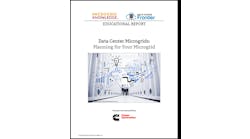Synthetic Inertia could be Solution to Grid Frequency Worries: November 1 Webinar
The electricity grid, while it provides energy for everyday life in nearly all facets, is hardly like other resources such as transportation fuels like gasoline or diesel.
Electrons can be stored in batteries at relatively small capacity and short durations, but it’s not like they can be kept in an underground tank at the local service station. Electrons must keep moving until they are consumed and grounded, and if the grid traffic falls below a certain frequency, it can be in danger of a complete outage with expensive and sometimes life-threatening consequences.
This almost happened to the Texas grid in February 2021 during Winter Storm Uri. A loss of GW in capacity threatened a near shutdown that forced operator Electric Reliability Council of Texas to shed load—which mitigated the threat of a grid collapse of power—but thousands of Texans lost their service during freezing temperatures. More than 50 people died as a result of hypothermia, according to reports.
Sometimes the opposite threat emerges and threatens the grid in the same way. Extreme heat, which prompts peak electricity demand from customers, can achieve the same effect. All extremes in load coupled with drops in capacity might slow the spin required on the grid.
This steady spin is called traditional inertia and it is pivotal to maintaining frequency. This threat against inertia has always compelled power plant operators to maintain “spinning reserves” to keep frequency at acceptable, operational levels.
However, utilities can have a new option called synthetic inertia as a capability to maintain grid frequency. Synthetic or virtual inertia can utilize the fast-growing number of distributed energy resources interconnecting in the grid such as microgrids, solar, wind and battery storage.
The innovation in distributed energy control and management systems makes synthetic inertia possible. But it’s a lot to wrap one’s head around.
To that end, microgrid control technology firm PXiSE Energy Solutions is leading a one-hour free webinar happening 2 p.m. (ET) on Wednesday, November 1. The event is hosted jointly by Microgrid Knowledge and T&D World.
The session will answer many questions utilities, end users and microgrid operators might have about how electricity management can guide synthetic inertia in replacing the traditional spinning reserves.
Fausto Perez, head of project delivery and support at PXiSE Energy Solutions, will lead the webinar. Perez has nearly a quarter of century's experience in energy industry projects, having worked at General Electric, AES, Sempra Energy and Recurrent Energy prior to joining PXiSE.
The momentum of the energy revolution toward a more decentralized and renewable energy grid and series of microgrids is already on pace. Utilizing new opportunities and technologies such as synthetic inertia can help smooth the path as utilities, commercial, industrial and residential customers remake the way the grid moves.
Join us for the 2 p.m. ET Wednesday, Nov. 1 webinar with PXiSE Energy Solutions, Microgrid Knowledge and T&D World. The webinar will be live and on demand for several months later.







